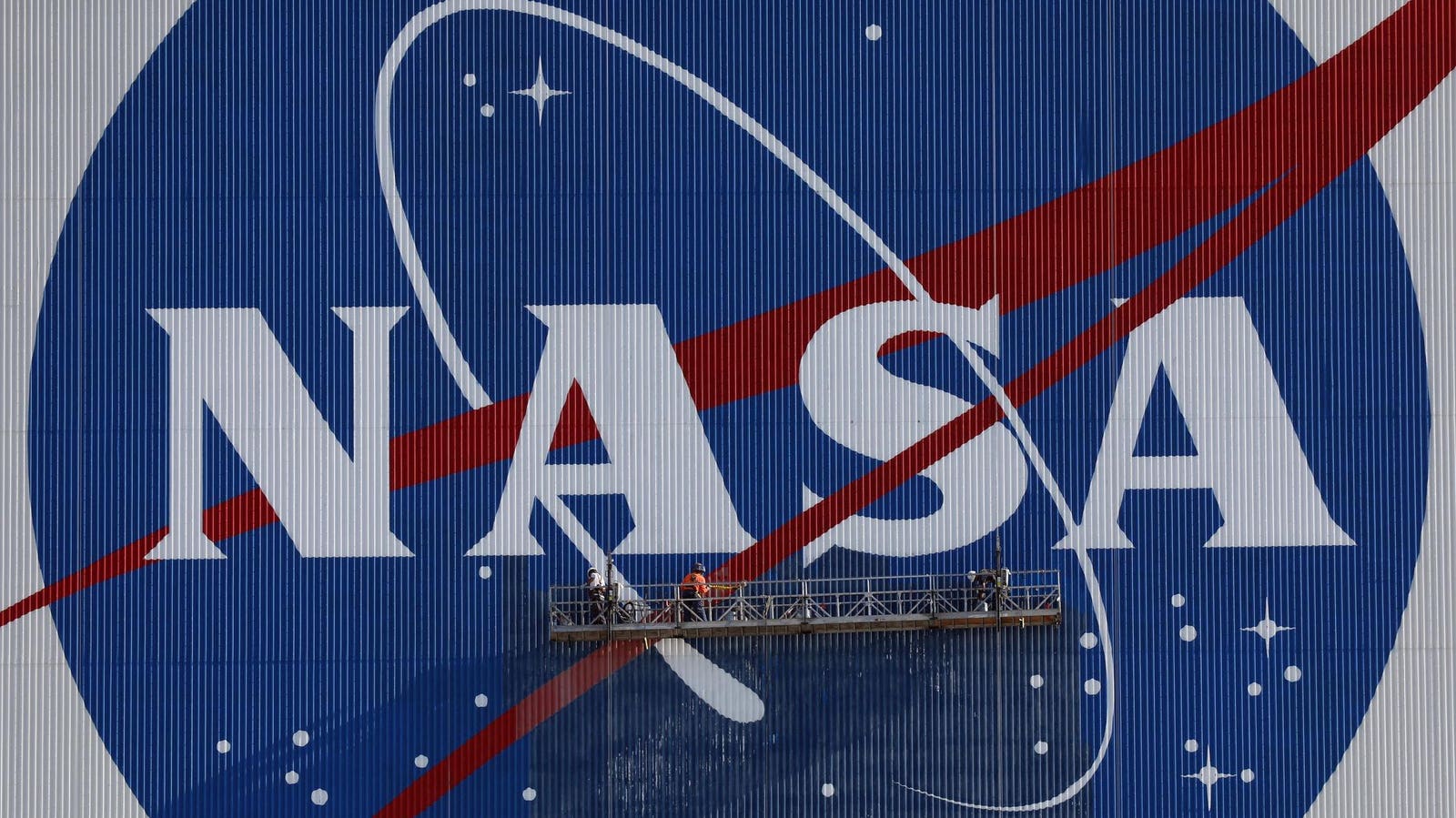Topline
NASA’s topline funding could be slashed by 24% and its science budget by 47% after what experts describe as a “destructive proposal” by the Trump Administration to cut almost $6 billion from the space agency’s budget. Some flagship NASA missions would be lost, but the proposal underscores the administration’s priority of returning to the moon before China and putting an American on Mars.
Painters refurbish the NASA logo on the Vehicle Assembly Building at the Kennedy Space Center in … More Florida in Florida on May 29, 2020. (Photo by Gregg Newton / AFP) (Photo by GREGG NEWTON/AFP via Getty Images)
Key Facts
Published Friday, May 2, the White House’s President’s budget for Fiscal Year 2026 would mean reducing the ambition of the space agency’s plans to return humans to the moon and canceling the flagship Mars Sample Return mission to bring Martian rock back to Earth. It would also mean “an end to climate-focused “green aviation” spending.”
The White House’s $1.7 trillion spending plan means $163 billion of cuts to federal spending for the next fiscal year. There are plans to reduce NASA’s science budget by 47%. NASA’s Earth Science Division includes satellite missions that monitor climate change, severe weather, natural hazards, wildfires, the ocean and global food production.
“The White House has proposed the largest single-year cut to NASA in American history,” reads a statement from The Planetary Society. “We urge Congress to swiftly reject this destructive proposal and instead pursue a path consistent with the President’s vision. This is an opportunity for a bipartisan agreement to secure an efficient, capable, and balanced national space program worthy of the nation it aims to represent.”
The proposals would also mean canceling Mars Sample Return, retiring NASA’s Space Launch System rocket and Orion capsule and ending its Lunar Gateway Program, the first international space station around the moon. On Apr. 4, Gateway’s first module arrived in Arizona from Italy.
The White House’s plans include a commitment to “returning to the Moon before China and putting an American on Mars.” In his inaugural address on Jan. 20, President Donald Trump said his administration would “launch American astronauts to plant the Stars and Stripes on the planet Mars.” Elon Musk, a senior advisor to the President and owner of SpaceX, recently stated that he wants to send humans to Mars as soon as possible.
Nasa’s Missions To The Moon
NASA’s Artemis program, a series of missions aimed at returning humans to the moon, would be curtailed under the plans. In December 2024, NASA delayed its Artemis II mission to April 2026. It will see four astronauts launch in NASA’s Orion capsule on its Space Launch System rocket and travel beyond the moon. The follow-up, Artemis III, will see two astronauts land on the moon. Both missions are preserved in the new proposals, but follow-up Artemis missions would be canceled, and both Orion and the SLS would be scrapped.
Among the proposals is the “continued elimination of any funding toward misaligned DEIA initiatives.” NASA had long intended Artemis III to “land the first woman and the first person of color” on the moon, language it recently quietly dropped from its website.
How Much Nasa Costs
According to The Planetary Society, NASA’s current budget of $25.4 billion is about 0.3% of federal spending. This proposal by the White House to reduce it to $18.8 billion is the initial step in a process that ultimately leads to Congress passing legislation. During the Apollo missions to the moon in the 1960s, it peaked at 4% of the federal budget.
‘loss Of American Leadership In Science’
There are concerns about this budget’s effect on science overall, including a 47% cut to NASA’s Science Mission Directorate, 56% to the National Science Foundation and 14% to the Department of Energy’s Office of Science. These proposed cuts “would result in a historic decline of American investment in basic scientific research,” according to a statement from the American Astronomical Society. Since many research efforts can require years to decades, the U.S. “will lose at least a generation of talent to other countries that are increasing their investments in facilities and workforce development,” continued the statement. “These proposed cuts will result in the loss of American leadership in science.”
Background
The proposal comes as the space agency is currently without a NASA Administrator. Jared Isaacman, the billionaire founder of payment processing company Shift4 Payments, was nominated in January 2025 and is going through confirmation hearings in the Senate. “Slashing NASA’s budget by this much, this quickly, without the input of a confirmed NASA Administrator or in response to a considered policy goal, won’t make the agency more efficient,” said The Planetary Society. “It will cause chaos, waste the taxpayers’ investment, and undermine American leadership in space.”
Further Reading
ForbesNASA Delays Flagship Crewed Moon Mission To April 2026 — What You Need To KnowBy Jamie Carter
ForbesNASA Urges Public To Look At Night Sky Now For ‘Nova’ LocationBy Jamie Carter
ForbesSoviet Probe May Strike Earth Next Wednesday — What To KnowBy Jamie Carter










